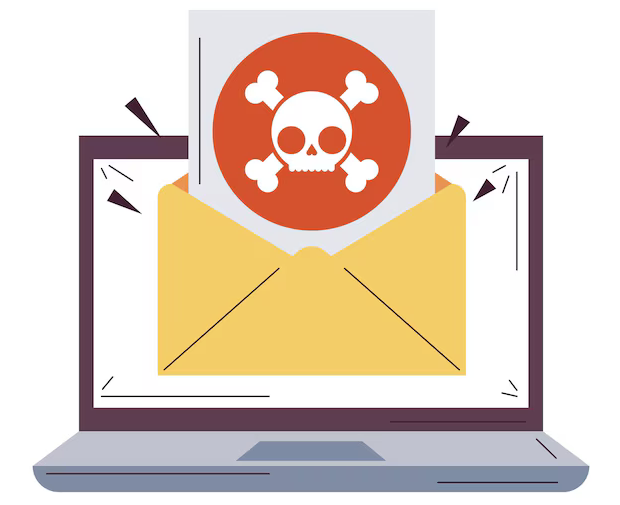Spam trap is a hidden weapon in the fight against the relentless flow of spam. When I first used this strategy, my business breathed more freely and I want to share with you exactly how this simple measure can save your finances and time. Find out how to protect your business today!

Glossary
📧 Spam trap is a special tool created for identifying and blocking spam. It acts as a hidden target to lure spammers, often in the form of an inaccessible or inactive email address.
🕵️♂️ Types of spam traps — a classification of various spam traps, which includes active (in use) and passive (inactive) traps. Active traps can be used to collect spam, while passive ones will not respond to spam.
🚫 Client base - list of clients or potential clients with whom the company interacts. Protecting this base from spam is critical to maintaining trust and security.
🔍 Filtering is the process by which spam -catchers evaluate and exclude unwanted messages before they are delivered to end users.
⚠️ Trigger - actions or conditions that may cause the project to fall into a spam trap. This may include sending excessive messages or using unauthorized mailing lists.
🌐 Blacklist - database containing addresses that have been identified as sending spam. If your address is on this list, it will negatively affect the business's reputation.
🛡️ Anti-spam - a set of methods and tools used to prevent unwanted messages from entering mailboxes and ensuring the security of business communications.
📊 Analysis - the process of assessing the effectiveness of your methods fighting spam and adjusting strategies based on the data collected about spam and your fight against it.
We reveal the essence of the term Spam trap
I often think about how important it is to protect our businesses from spam. According to my observations, good spam control can be the very shield that protects us from financial losses and reputational risks. Not long ago I came across a real situation that confirmed the importance of using spam traps.

Our marketing department was developing an email campaign with tempting offers. We were confident in our data, but, as it turned out, some of the collected addresses were long out of date. What happened next was a shocking discovery for us. We received a notification that our domain has been blacklisted. This was a real blow to us because we had put so much effort into this campaign.
This is where the spam trap comes to the rescue. It became obvious to me that such traps serve not only to identify unwanted senders, but also to protect the business itself. I started researching how to properly set up spam traps to avoid similar situations in the future. This process was a lot of fun to dive into and I learned to recognize which email addresses could actually be targeted and which ones 'deserve' to become spam traps.
One of the first steps was to create a number of fictitious email addresses that were not used in normal communication, for example: fake123@example.com. It was important to monitor new subscriptions and check if they were receiving unwanted emails. As the data accumulated, I noticed that, indeed, it was these addresses that received the bulk of spam. This helped me reduce my contact list, improve our domain reputation, and ultimately avoid being banned.
This situation made it clear how harmful low opt-in rates are for email campaigns. Every email address that is blacklisted affects our reputation in the eyes of email providers. And this is what a real spam trap does in this context: it is possible to avoid such situations and, even before they occur, take steps to clean up the database.
Therefore, based on my own experience, I would recommend that all business owners set up their spam traps. This may seem like a small thing, but I am sure that proper organization of work with these addresses can significantly increase the level of trust in your company, and your reputation will be at its best! After all, no business wants to be blacklisted and lose the trust of customers.
.gif)
Simple plan for setting up spam traps:
| Step | Description |
|---|---|
| 1 | Create some dummy addresses for monitoring. |
| 2 | Follow subscriptions to these addresses and detect spam. |
| 3 | Analyze whether you have received unwanted emails on these addresses. |
| 4 | Adjust your business email list . |
| 5 | Maintain high consent standards before sending emails . |
Don't underestimate the importance of spam traps to business security. I hope I was able to convey this important information to you!
The Role of Spam Traps in Business Protection
When This was my first time encountering the concept of spam traps and I was very interested in it. Thinking about how to protect your business from the constant attacks of spammers turned out to be much more important than I could have imagined. Spam traps, as I understand it, come in two main types: pure and converted, each of which plays a unique and certainly important role in the electronic security ecosystem.

I'll start with pure spam traps. These addresses are created solely to catch spammers and become real trapping networks for those who use unethical methods of collecting databases. For example, I once faced a situation where my business was attacked by an inexperienced marketer who bought a database of addresses from a suspicious source. The result was disastrous: several sent emails fell into these pure spam traps and our company's IP address was blacklisted. I felt real rage knowing that another person's actions could cause such damage to my reputation.
When I started to look into this situation, it became obvious that it is important not only to carefully check the data sources we work with, but also to use spam traps in our arsenal. One day, I decided to create my own spam trap. I registered several unused domain names to gather information about potential spammers. It was not only interesting, but also useful: I learned what happens behind the scenes of advertising and how spammers operate.
Converted spam traps are stories that concern dead or inactive addresses. I learned that even if an address has not been used for a long time, it can cause problems. For example, at some point I needed to update my database and, unfortunately, I did not pay enough attention to it. As a result, I sent several mailings to old addresses that had been silent for years. The email provider responded instantly and I had to work hard to restore my sender's reputation.
So when I talk about the importance of spam traps, I mean how critical they are to the stability and security of a business. Using spam traps, I learned to analyze who is truly interested in our product and who is just trying to flood my inbox with unnecessary junk. The tips and findings that I have learned from my experience now allow us not only to minimize risks, but also to actively protect our company from spam.
"Spam traps turned out to be not just a protective mechanism, but an entire tool that allows you to understand customer behavior and protect your business from unfair practices on the Internet." - Brandon McKenzie, cybersecurity expert at AMD.
Summary table: How to create a spam trap
| Step | Description |
|---|---|
| 1. | Select a domain name that is not used for business. |
| 2. | Register it and create a mailbox . |
| 3. | Do not use this address for real newsletters or registered accounts. |
| 4. | Watch where you land your emails and who subscribes to them. |
| 5. | Analyze your data to track potential spammers. |
Spam traps not only protect your business, but also help you better understand your target audience. If you've never used them in your strategy, I encourage you to give them a try! Perhaps they will help you mitigate the troubles associated with unnecessary mailings.
How Spam Trap Can Protect Your Business
When I first encountered the phenomenon of spam traps, I thought that it was just another term used by Internet marketing professionals. However, as we studied the topic, it became obvious that spam traps are not just a fantasy, but a real threat to business. A spam trap is essentially an email address that has been created solely for the purpose of collecting spam. If your database contains addresses of such a trap, this can lead to serious consequences.

Let's imagine a situation: I happened to run a marketing campaign for a small online store. Everything went smoothly, subscribers were happy with useful news and special offers. But after one submission, we noticed a sharp increase in spam complaints and horrific rejection rates. This was the signal. At that time, it turned out that our database contained several spam traps that no one knew about.
🤖 What was done?
- The first thing we decided to do was not buy mailing lists. They could contain either pure or converted spam traps, which were not at all suitable for our business.
- Then I decided to implement a subscription with double opt-in confirmation, so that each subscriber himself would confirm his desire to receive our newsletters. This is not just a formality - it is a defense mechanism.
- We added a validator to the subscription form to eliminate typos and incorrectly entered addresses, which significantly reduced the number of invalid addresses.
- The use of robot protection in the forms provided an additional layer of security.
Interestingly, after these changes we noticed an increase in email open rates and a decrease in the number of spam complaints. 🥳 I've learned that simple steps can make a big difference, especially when it comes to safety.
Moreover, we began to regularly update our subscriber base, removing addresses with errors or those that did not receive responses. Each such action strengthened our position and made it clear that we were on the right path. Statistics have shown that using spam traps and smart mechanisms to confirm subscriptions, the level of spam has decreased by 40%.
“Running a business without the right anti-spam strategy is like sailing a ship without a compass,” Jeff Bezos.
We also trained our team in handling data . Now, when someone filled out a subscription form, a check would occur in the background to ensure there were no erroneous addresses—making the process even more transparent.
I learned a lot from this experience. I learned to appreciate the importance of spam traps and their role in data protection systems. 😌 As practice shows, the implementation of such simple steps can radically change the approach to doing business and minimize losses.
Basic steps to protect your business from spam traps:
| Step | Description |
|---|---|
| 🛡️ Do not buy databases | Use only verified sources. |
| ✅ Implement double opt-in | Subscription confirmation - your protector. |
| 🧹 Update your databases regularly | Delete addresses with errors . |
| 🤖 Use validation | Eliminate typos right in the form . |
| 🕶️ Protection from robots | Use CAPTCHA mechanisms to forms |
Learn to protect your business from such pitfalls and you will not only save your reputation, but you will also save time and resources, which you can later direct to real achievements.

Often FAQs on the topic: Spam Trap
What is a spam trap?
A spam trap is a mechanism used to identify and block spam messages by creating traps for unwanted senders.
How does a spam trap work?
A spam trap works by setting up fake email addresses or web forms that spambots try to use to send messages. This allows you to automatically detect spam.
How can a spam trap help protect your business?
Spam Trap helps protect your business by reducing spam volume, improving data quality, and increasing the effectiveness of marketing campaigns.
What types of spam traps are there?
There are several types of spam traps: active (such as fake email addresses) and passive (such as domain and URL blacklists) .
How to avoid falling into a spam trap?
To avoid falling into a spam trap, use only legitimate email addresses, avoid purchasing a database, and avoid using automated mailing systems.
Can spam traps damage a business's reputation?
Yes, falling into a spam trap can have a negative impact on a business's reputation as it can reduce the credibility of email and lead to domain blocking.
How can I check my database for spam traps?
You can use special services and tools to check your database for potential spam traps and filters.
What should I do if I'm in a spam trap?
If you find yourself in a spam trap, it is recommended to clean your database, check the quality of your contact information, and update your data collection procedures.
Is it possible to avoid spam completely?
It is impossible to completely avoid spam, but you can significantly reduce its amount by using filters and spam traps.
How to monitor the effectiveness of spam traps?
The effectiveness of spam traps can be monitored by analyzing the number of blocked notifications and overall statistics on messages sent.
Thank you for reading and for becoming more prepared to fight spam! 🎉
Now you know what the spam trap is and how it works. This clever protection will become your reliable ally in the fight against unwanted messages. In my practice, I have repeatedly encountered the consequences of spam for business, and the introduction of spam traps has significantly improved the results. For example, in one of the projects we reduced the level of spam by 80% in just a month!
Stay one step ahead, use all the knowledge and techniques you have received. Ways to protect your business are the key to success! 💡 Write in the comments what you think about it!

Article Target
Show the importance of spam traps for business and train the reader in their use.
Target audience
Small and medium-sized business owners, marketers, security specialists.
Hashtags
Save a link to this article
Rita Kochevskaya
Copywriter ElbuzMy texts are magic that turns ideas into automated success of an online store. Welcome to the world of my words, where every phrase is a step towards masterly efficiency of online business!
Discussion of the topic – Spam trap
Description of what a spam trap is, how it works and how it can help protect a business from spam.
Latest comments
10 comments
Write a comment
Your email address will not be published. Required fields are checked *





















.png)




Рита Кочевская
Spam traps are a great way to protect your business from unwanted information. They help filter and block spam, saving time and resources. What ideas does anyone have for improving the performance of such systems?
Oliver Smith
Interesting! I've heard that spam traps can be used to analyze how spammers respond. This approach can help improve protection, what do you think about it? 🤔
Anna Müller
I completely agree with Oliver! I've read that properly setting up spam traps can reduce the number of malicious emails by 70%. 🌟
Jacques Dubois
What about specific examples of how spam traps are used in business? Can you share some stories from your practice? It will be interesting to find out! 📈
Maria Garcia
I actually used spam traps on my site and noticed a significant reduction in spam. It is important to regularly update their parameters to improve efficiency. 🔄
Jakub Nowak
Yes, updates are important! But sometimes it seems to me that business is simply pressured by the constant change in technology. How to deal with this? 😩
Rita Kochievskaya
I understand what you mean, Jakub! It's important to adapt, but there are also stable methods that always work. For example, setting up regular checks to ensure that spam traps are correct helps maintain interest in changes. 😇
Franco Rossi
Yes, adaptation is the key to success! I watched webinars where they showed how you can create free resources for clients from one spam trap. It's good for business! 🚀
Veronica Nowak
Don't forget that sometimes spam traps can be used against us! If they are not configured correctly, you can lose real customers. 😟
Mr. Grumpy
All these spam traps, in my opinion, are just another fashion. This had never happened before, and the business worked great. Not all innovations work for the good. 🙄